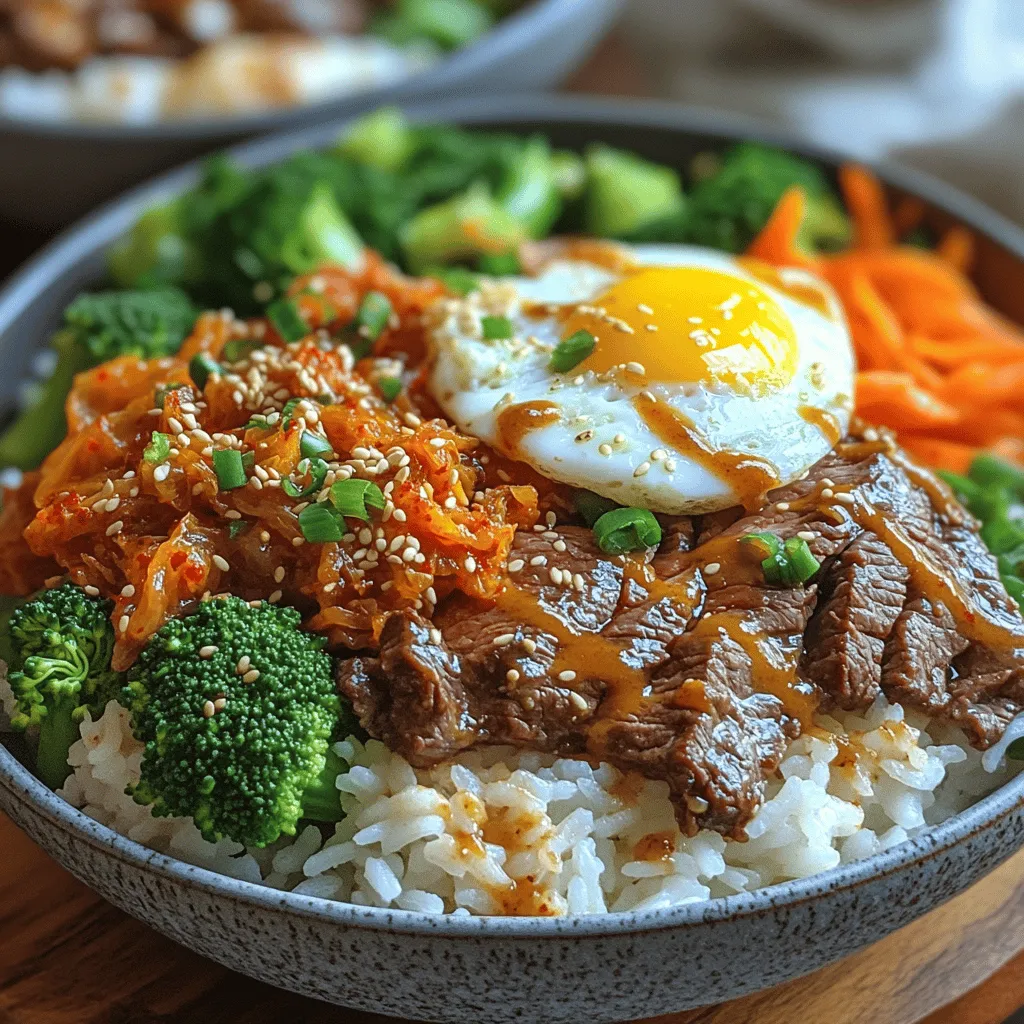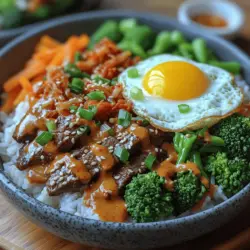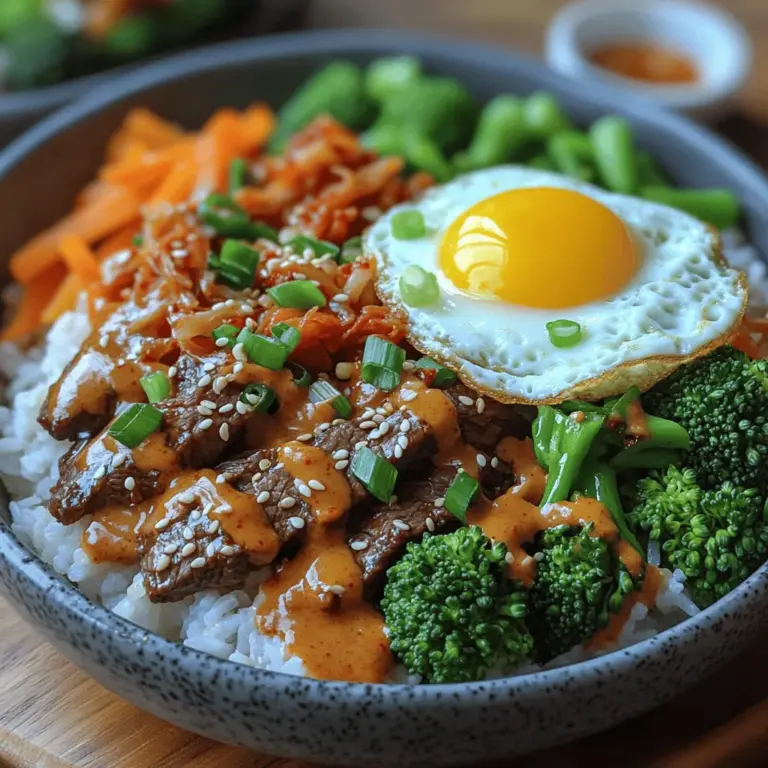Introduction
Korean cuisine has gained immense popularity worldwide, admired not only for its rich flavors and vibrant colors but also for its emphasis on balance and health. Characterized by a blend of spicy, savory, and sweet notes, Korean dishes often feature a variety of ingredients that contribute to a well-rounded dining experience. Among the many delectable offerings of this culinary tradition, Korean Beef Bowls stand out as a delightful meal option that brings together a medley of tastes and textures, making it a favorite for both seasoned cooks and beginners alike.
Korean Beef Bowls are a perfect representation of the harmony found in Korean cooking. Tender marinated beef, often served over a bed of fluffy rice, is complemented by an array of vegetables, which add crunch and freshness. The dish is not only visually appealing but also nutritionally balanced, providing a satisfying meal that can be enjoyed any day of the week.
One of the most appealing aspects of Korean Beef Bowls is their simplicity in preparation. With a few key ingredients and straightforward cooking techniques, home cooks can create a flavorful dish that rivals those found in traditional Korean restaurants. This recipe highlights how accessible Korean cuisine can be, encouraging anyone to embark on a culinary adventure in their own kitchen.
Understanding the Ingredients
To create an authentic and flavorful Korean Beef Bowl, it’s essential to understand the key ingredients that make this dish shine. The star of the show is flank steak, a cut of beef known for its rich flavor and ability to absorb marinades well. Flank steak is a lean cut that, when marinated, becomes tender and juicy, making it an excellent choice for this recipe.
Flank Steak
Flank steak is particularly suitable for marinades due to its fibrous texture. When marinated, it not only absorbs flavors but also becomes more tender, making it a great option for quick cooking methods like grilling or stir-frying. This cut is often used in Korean BBQ, and its ability to soak up the marinade enhances the overall taste of the dish.
Marinade Components
The marinade plays a crucial role in flavoring the beef. Here’s a breakdown of the essential components:
– Soy Sauce: This staple ingredient is the backbone of the marinade, providing a salty, umami flavor that complements the beef beautifully. Soy sauce also helps to tenderize the meat, ensuring it’s juicy and flavorful.
– Brown Sugar: The addition of brown sugar balances the savory notes of the soy sauce with a hint of sweetness. This contrast enhances the overall flavor profile of the dish, making each bite satisfying.
– Sesame Oil: Known for its distinct aroma and flavor, sesame oil adds depth and richness to the marinade. A little goes a long way, infusing the beef with a nutty taste that is characteristic of many Korean dishes.
– Garlic and Ginger: These aromatic ingredients are essential for adding complexity to the marinade. Garlic brings a pungent, savory note, while ginger introduces a subtle spiciness that brightens the dish.
– Rice Vinegar: The acidity of rice vinegar plays a vital role in tenderizing the meat while also enhancing the overall flavor. It adds a refreshing tang that balances the richness of the other ingredients.
– Cornstarch: Often overlooked, cornstarch is included in the marinade to create a velvety texture on the beef. It helps to seal in moisture, ensuring that the meat remains juicy during cooking.
Marinade Preparation
Now that we understand the importance of each ingredient, it’s time to prepare the marinade. Here is a step-by-step guide to creating a flavorful marinade that will elevate your Korean Beef Bowl.
1. Gather the Ingredients: Ensure you have all the marinade components ready: soy sauce, brown sugar, sesame oil, minced garlic, grated ginger, rice vinegar, and cornstarch.
2. Mix the Marinade: In a medium-sized mixing bowl, combine 1/4 cup of soy sauce, 2 tablespoons of brown sugar, 1 tablespoon of sesame oil, 2 cloves of minced garlic, 1 tablespoon of grated ginger, 1 tablespoon of rice vinegar, and 1 tablespoon of cornstarch. Whisk the ingredients together until the sugar is dissolved and the mixture is well combined.
3. Prepare the Beef: Slice the flank steak against the grain into thin strips. This technique ensures that the meat is tender and easy to chew. The thinner the slices, the better they will absorb the marinade.
4. Marinate the Beef: Place the sliced beef into a resealable plastic bag or a mixing bowl. Pour the marinade over the beef, ensuring that each piece is evenly coated. Seal the bag or cover the bowl with plastic wrap.
5. Marinating Time: Allow the beef to marinate in the refrigerator for at least 30 minutes, but for maximum flavor, aim for 2 hours or even overnight. The longer the beef sits in the marinade, the more flavorful it will become.
6. Cooking Technique: When ready to cook, you can either grill, stir-fry, or pan-sear the marinated beef. Each method will result in a deliciously caramelized exterior and tender interior, perfect for serving over rice.
Vegetable Preparation
To complement the marinated beef, it’s important to select a variety of vegetables that not only add color and texture but also pack a nutritional punch. For this Korean Beef Bowl recipe, we will use broccoli, carrots, and kimchi.
Chosen Vegetables
– Broccoli: This nutrient-dense vegetable is rich in vitamins C and K, fiber, and antioxidants. It adds a vibrant green color to the dish and a satisfying crunch when cooked properly.
– Carrots: Sweet and crunchy, carrots provide not only a splash of color but also essential vitamins and minerals, including beta-carotene. They can be julienned for an attractive presentation that enhances the overall appeal of the dish.
– Kimchi: A traditional Korean side dish made from fermented vegetables, kimchi brings a tangy, spicy flavor that perfectly complements the savory beef. It is also a source of probiotics, making it a healthy addition to the meal.
Cooking Techniques for Vegetables
When preparing the vegetables for your Korean Beef Bowl, there are a few techniques that will ensure they retain their color and nutrients:
– Steaming Broccoli: To cook broccoli while preserving its bright green color and crunch, steaming is an excellent method. Simply bring a pot of water to a boil, place the broccoli in a steamer basket, and steam for 3-5 minutes until tender but still crisp.
– Julienning Carrots: For an appealing presentation, julienne the carrots into thin strips. This can be done with a sharp knife or a julienne peeler. Aim for uniform sizes to ensure even cooking.
– Incorporating Kimchi: Kimchi can be served on the side or mixed into the bowl. If you prefer to warm it slightly, you can sauté it in a pan for a minute or two to enhance its flavors without losing its probiotic benefits.
By understanding the ingredients and preparation techniques, you are well on your way to creating a delicious and satisfying Korean Beef Bowl. Keep an eye out for the next part of this article, where we will delve into the step-by-step cooking process and final assembly of this delightful dish.

Cooking the Beef
When it comes to preparing the beef for your Korean Beef Bowls, the method of cooking can dramatically affect the end result. The two most common techniques are using a skillet or a wok. Both have their advantages, but the choice may depend on your kitchen equipment and personal preference.
Skillet vs. Wok
A skillet is an excellent choice for beginners or those with limited cookware. It allows for even cooking and is readily available in most kitchens. However, a wok is the traditional tool for stir-frying and is designed to handle high heat efficiently. The shape of a wok allows the beef to cook quickly and evenly, ensuring a delicious stir-fry that retains the meat’s tenderness.
Importance of High Heat for Searing the Beef
Regardless of the cookware you choose, high heat is crucial for searing the beef. This technique not only enhances the flavor through caramelization but also helps to lock in the juices, resulting in a tender and flavorful bite. Preheat your skillet or wok until it’s very hot before adding the beef. This step is essential in achieving that sought-after crust that characterizes a good stir-fry.
Tips for Cooking in Batches
To prevent steaming the meat, it’s advisable to cook the beef in batches. Overcrowding the pan leads to a drop in temperature and causes the beef to steam rather than sear. Aim to cook in small portions, allowing each piece to have maximum contact with the hot surface. This method not only improves texture but also enhances the overall flavor of the dish.
Indicators of Doneness for Perfect Beef
When cooking your beef, look for color and texture as indicators of doneness. For a medium-rare finish, the beef should be a rich brown on the outside while remaining slightly pink inside. If you prefer your beef more well-done, allow it to cook until it reaches an internal temperature of 160°F (71°C). Always remember to remove the beef from the heat slightly before it reaches your desired doneness, as it will continue to cook while resting.
Assembling the Bowls
Once your beef is cooked, it’s time to assemble your Korean Beef Bowls. This step is not only about combining ingredients but also about creating an appealing presentation.
Visual Presentation Tips
A well-assembled bowl is visually appealing and can enhance the dining experience. Use a deep bowl to showcase the ingredients and create layers. Start with a base of rice, then add the beef, followed by vegetables, and finish with garnishes. Aim for a balance of colors and textures, creating a feast for the eyes.
Step-by-Step Assembly Process
1. Start with the Rice: Spoon a generous serving of cooked rice into each bowl, filling it about halfway.
2. Add the Beef: Layer the seared beef on top of the rice. Ensure that each portion is evenly distributed so that every bite contains a taste of the marinated beef.
3. Incorporate the Vegetables: Add your choice of vegetables around the beef. This can include sautéed bell peppers, carrots, and snap peas. You can also add fresh greens like spinach or cucumber for a refreshing crunch.
4. Finish with Garnishes: Top the bowl with finely sliced green onions and a sprinkle of sesame seeds. For added flavor, consider including a dollop of kimchi or a side of pickled vegetables.
Importance of Layering Ingredients
Layering the ingredients is key to flavor distribution. Each spoonful should offer a balance of rice, beef, and vegetables, ensuring that no flavor is left behind. Additionally, this technique creates a delightful textural contrast, making each bite enjoyable.
Garnishing and Serving Suggestions
Garnishing plays a pivotal role in enhancing both the flavors and aesthetics of your Korean Beef Bowls. The right garnishes can elevate the dish from simple to spectacular.
The Role of Green Onions and Sesame Seeds
Green onions provide a fresh, sharp flavor that complements the rich beef. Their bright color also adds visual appeal. Sesame seeds, on the other hand, bring a nutty flavor and a delightful crunch. Together, these garnishes create an inviting presentation.
Optional Toppings
To personalize your dish, consider adding optional toppings such as:
– Fried Eggs: A sunny-side-up egg on top adds creaminess and richness.
– Sriracha or Gochujang: For those who enjoy a spicy kick, drizzle a little Sriracha or Korean chili paste (gochujang) over the top.
– Avocado: Sliced avocado can add a creamy texture and a dose of healthy fats.
Suggestions for Serving
For a complete meal, consider serving your Korean Beef Bowls with side dishes such as:
– Kimchi: This traditional Korean side dish not only adds flavor but also provides probiotics for gut health.
– Steamed Vegetables: Broccoli or bok choy can complement the flavors in the bowl.
– Beverages: Pair the meal with a light drink, such as iced green tea or a crisp lager, to refresh the palate.
Nutritional Profile of Korean Beef Bowls
Understanding the nutritional value of your Korean Beef Bowls can enhance your appreciation for this dish. Here’s a breakdown of what you can expect per serving:
Breakdown of Calories and Nutrients
A typical serving of Korean Beef Bowls contains approximately:
– Calories: 500-600, depending on the portion sizes and ingredients used.
– Protein: 30-40 grams from the beef, providing a satisfying source of this vital nutrient.
– Carbohydrates: 60-70 grams primarily from the rice and vegetables.
– Fats: 15-25 grams, depending on the cut of beef and any added oils or toppings.
Discussion on Macronutrient Balance
This dish offers a balanced composition of macronutrients. The carbohydrates from rice fuel your body, while the protein from beef aids in muscle repair and growth. Including vegetables not only increases fiber but also adds essential vitamins and minerals, contributing to a well-rounded meal.
Health Benefits of Incorporating Vegetables and Fermented Foods
The inclusion of vegetables boosts the nutritional profile of the dish, while fermented items like kimchi provide probiotics that support digestive health. Eating a variety of vegetables helps reduce the risk of chronic diseases and promotes overall well-being.
Cultural Significance of Korean Beef Bowls
Korean Beef Bowls are more than just a delicious meal; they encapsulate the rich culinary traditions of Korea.
Exploration of Korean Culinary Traditions
Korean cuisine is known for its bold flavors, vibrant colors, and emphasis on fresh ingredients. The use of marinades, such as soy sauce, garlic, and sesame oil, reflects the deep-rooted culinary techniques that have been passed down through generations. Korean Beef Bowls are a testament to the importance of harmony between flavors and textures in Korean cooking.
Discussion on Korean Comfort Food
This dish fits neatly into the category of Korean comfort food, often enjoyed during family gatherings or celebrations. The act of sharing a meal with loved ones is central to Korean culture, and Korean Beef Bowls embody this spirit of togetherness.
Personal Anecdotes and Historical References
Many families in Korea have their own variations of this dish, often passed down through generations. Each version tells a story, connecting individuals to their heritage. Whether it’s a bowl enjoyed at a bustling family dinner or a comforting meal on a rainy day, Korean Beef Bowls evoke feelings of nostalgia and warmth.
Conclusion
Korean Beef Bowls are a beloved dish that combines bold flavors, colorful ingredients, and rich cultural significance. The ease of preparation makes them accessible for home cooks of all skill levels, while their adaptability allows for customization to suit various dietary preferences.
By following the outlined steps for cooking, assembling, and garnishing, you can create a visually stunning and delicious meal that is sure to impress. Whether enjoyed as a family dinner or a quick weeknight meal, Korean Beef Bowls promise a delightful culinary experience that captures the essence of Korean cuisine.
So, roll up your sleeves and try making these flavorful bowls at home. Experience the delightful textures and rich flavors that make Korean Beef Bowls a cherished favorite in kitchens around the world.


